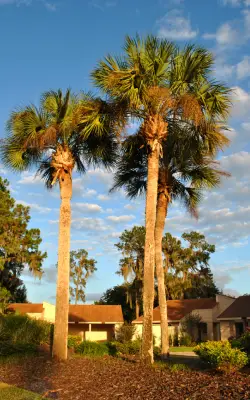Majestic Tree Service is proud to provide specialized palm tree maintenance service in San Jose and San Ramon. To schedule a consultation or for a complimentary estimate, give us a call anytime.
In the meantime, to help get you started, we’ve put together this comprehensive guide to maintaining your palm trees. If you ever have questions, don’t hesitate to reach out.
How to Maintain Palm Trees in San Jose & San Ramon

Palm trees thrive in regions that offer a balance of abundant sunshine, mild winters, and soil that lets their roots breathe. Here in the Bay Area, we’re fortunate — our local climate, from the warm, inland valleys of San Ramon to the sun-drenched neighborhoods of San Jose, provides a fantastic environment for many beautiful types of palms.
But even in this environment that produces so many happy palm trees, sometimes keeping them looking their best and ensuring they live long, healthy lives requires a little specialized care.
Since 2012, Majestic Tree Service has been the trusted partner for homeowners and commercial property managers throughout San Ramon and San Jose and the surrounding communities. We’ve seen firsthand what it takes to make these trees thrive in our local environments.
To get you started, here are our top five tips for successful palm tree maintenance and care in the Bay Area:
- Watering the right amount is important. It’s about depth, not frequency.
- Fertilizers can make a huge difference. What (and when) you feed them matters.
- Don’t overprune your palm trees. This is a common mistake.
- Know what kind of palm trees you have, and learn their needs.
- Working with a professional tree care company can save you time.
Leave your information below, and we’ll give you a call back as soon as possible!
Caring for Palm Trees in the Bay Area Climate
Those tips are a great starting point, but the most important part of palm tree maintenance is understanding that it’s not a one-size-fits-all checklist. The right technique for a towering Canary Island Date Palm is very different from that for a clustered Mediterranean Fan Palm.
Also, the Bay Area is famous for its microclimates. A palm in a breezy, cooler part of San Jose might have entirely different watering and feeding needs than one in a hot, sheltered courtyard in San Ramon. It’s up to you to observe your specific tree and its unique environment to decide what’s best – or consult with a local arborist.
#1 How to Water a Palm Tree Properly
It’s easy to assume palms need constant water, but most problems we see come from the wrong kind of watering. Palms hate “wet feet,” which is what happens when their roots are constantly sitting in soggy soil. This can lead to root rot and fungal infections.
In their native climates, palms are used to infrequent but deep, drenching rains. Your goal is to mimic this. Shallow, frequent watering (like a lawn sprinkler) only moistens the top few inches of soil, encouraging a weak, shallow root system that is vulnerable in a drought.
- Soak, Don’t Spray: Avoid watering when the soil is still damp. When it’s dry, use a soaker hose or let a garden hose trickle slowly at the base of the palm for an extended period (sometimes an hour or more for large, established trees). You want the water to penetrate at least two feet down into the soil.
- Adjust Based on the Season: You will need to water more frequently during the hot, dry spells of late summer and very little (if at all) during a cool, wet winter.
#2 How Important Is Fertilizer to Palm Trees?
It can be very important because palms are picky eaters. They have highly specific nutritional needs that standard lawn fertilizer simply cannot meet. In fact, a high-nitrogen lawn fertilizer can actively harm a palm by creating nutrient imbalances.
The solution is a slow-release fertilizer made specifically for palms. These are formulated with the proper ratio of micronutrients that palms crave. The most common nutrient deficiencies include:
- Potassium (K): This is the most common issue. It appears as yellow or orange spots on the oldest fronds.
- Magnesium (Mg): This shows up as a distinct yellow band along the edges of older fronds, while the center of the frond stays green.
- Manganese (Mn): This is a serious one, known as “frizzle top.” It affects the newest fronds, causing them to emerge stunted, scorched, or frizzled.
#3 Be Careful with Pruning
A palm tree is incredibly self-sufficient. As a frond ages, turns yellow, and then brown, the tree is actively pulling all the remaining nutrients from that dying frond to feed its new growth. When you cut off a yellowing frond, you are literally stealing your palm’s next meal.
This is the most common (and most damaging) DIY mistake we encounter. It’s tempting to trim off any fronds that aren’t perfectly green to “clean up” the look of the tree, but please put the loppers down.
Avoid these common palm tree pruning mistakes:
- Never prune fronds that are pointing upward or are horizontal. A frond should only be removed once it is completely brown and hanging down.
- Never “skin” the trunk by aggressively pulling off old frond bases (or “boots”). This can tear the trunk’s “skin,” creating a wound that invites pests and disease.
- Never, ever cut off the top, central growing point of the palm (the “bud” or “heart”). A palm only has this one growth point, and if you cut it, the tree will die.
#4 Know Your Palm Trees
Recognizing the type of palm you have is the most important first step in its care, as its needs for pruning, feeding, and watering can vary significantly.
Common Types of Palm Trees in the Bay Area

- Mexican Fan Palm (Washingtonia robusta): This palm retains a “skirt” of dead fronds that hangs down the trunk. While some owners like this rustic look, it can become a fire and pest hazard. Pruning this skirt is a job that requires caution due to the tree’s height.
- Queen Palm (Syagrus romanzoffiana): A heavy feeder and is the most likely palm in our area to show signs of “frizzle top” (manganese deficiency). It requires a regular feeding schedule with a palm-specific, slow-release fertilizer to stay deep green and healthy.
- Canary Island Date Palm (Phoenix canariensis): Due to its size and the dangerous spines at the base of each frond, this is not a DIY tree. Pruning requires specialized safety equipment and knowledge.
- Mediterranean Fan Palm (Chamaerops humilis): This is a very hardy and water-wise choice for our region. Maintenance usually involves selectively pruning out the oldest, brownest fronds at the base to keep it clean.
- King Palm (Archontophoenix cunninghamiana): It generally requires very little pruning. It does, however, appreciate more consistent water than some other palms.
- Chinese Windmill Palm (Trachycarpus fortunei): This is a very low-maintenance palm. It typically only needs a light “clean-up” pruning every few years to remove the few fronds that have turned brown.
#5 When Should You Work with a Professional Palm Tree Expert?
After learning all this, you might feel that palm tree care is more complex than it first appears—and you’re right. Beyond the science, there’s the simple matter of practicality and safety. Those beautiful fronds are also heavy, sharp, and often 30, 40, or 50+ feet in the air.
A professional tree care company like Majestic Tree Service is your best partner when:
- Safety is a Concern: Are the fronds near power lines? Is the tree taller than you can comfortably reach with a pole saw? Don’t risk a life-altering fall. Our crews are certified, insured, and have the specialized lift equipment to work at height safely.
- You’re Not Sure What’s Wrong: A misdiagnosis can be fatal for the tree. We can accurately identify the difference between a nutrient problem and a pest infestation and create a targeted treatment plan.
- The Job is Just Too Big: A single palm frond can weigh over 50 pounds. A full pruning job is exhausting, dangerous work. We can handle the difficult labor and, just as importantly, we haul away all the heavy, bulky debris.
For more information about maintenance and other palm tree services we offer, give us a call!
Back to Palm Tree Services